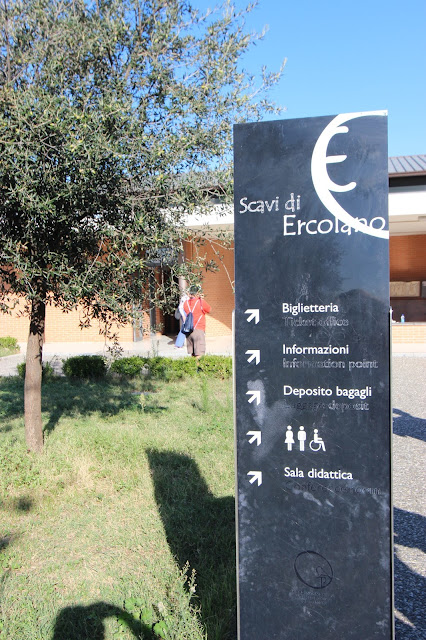We were within a 30 minute drive of the town but, as in many cruise excursions to interesting places there was a "shopping break" built-in. In this case it was a 45 minute stop at a Cameo shop where skilled artists create those tiny portraits or scenes on pieces of glass or shell. Fascinating but not something either of us would wear or buy as a gift. However these stops are good for one thing for the non-shopper-they always have restrooms!
So it was a minor diversion and soon we were back on the bus and drove only a couple of miles through the narrow streets until we were at the site of the ancient town of Herculeum. In Italian it is Ercolano so I'll refer to it as that from here on in. Although it was only a town of 4,000 or so people compared to 17,000 estimated to be in Pompeii when the volcano erupted there was still plenty of walking ahead.
Unlike Pompeii the whole town could be viewed from standing near the entrance. It is overlooked by the modern town of Ercolano.
Vesuvius appears in the frame at extreme right
We cross over a metal ramp into the town streets and pass a garden with lemon trees.
The last time any of the buildings we would see were lived in was August 79 A.D. Most people had a chance to flee the first eruption but at least 300 skeletons were found when the town was first discovered in the 18th Century. A young lady from our ship visited in her wheelchair and had help getting up onto the ancient sidewalks.
The town had lain hidden for centuries under 50 feet of volcanic ash
Most of the structures still stand although their roof caved in under the weight of ash
Our tour guide talks to us through wireless headsets as we walk along in the sun. I stay apart from our group to take photos and can still follow the commentary.
The town was a seaside resort back then. The sea has since moved far away. It would have been a fishing port and busy trading center for the catch of the day.
Houses from the modern town line the site border.
Structures built to last
Mosaics survive intact
Layers of ash are braced by scaffolding poles while archaeologists work on the restoration
Once you cross over into the site there are no shops where you can buy drinks so take water with you.
The espresso and beer can wait until you are back outside. The same applies to toilets.
Narrow streets
1900 years old brickwork, strong as ever
Occasional signage highlights buildings of special interest
Visitors without personal guides can rent headsets and be guided by narration
Tiles to channel water
To be continued....



























No comments:
Post a Comment